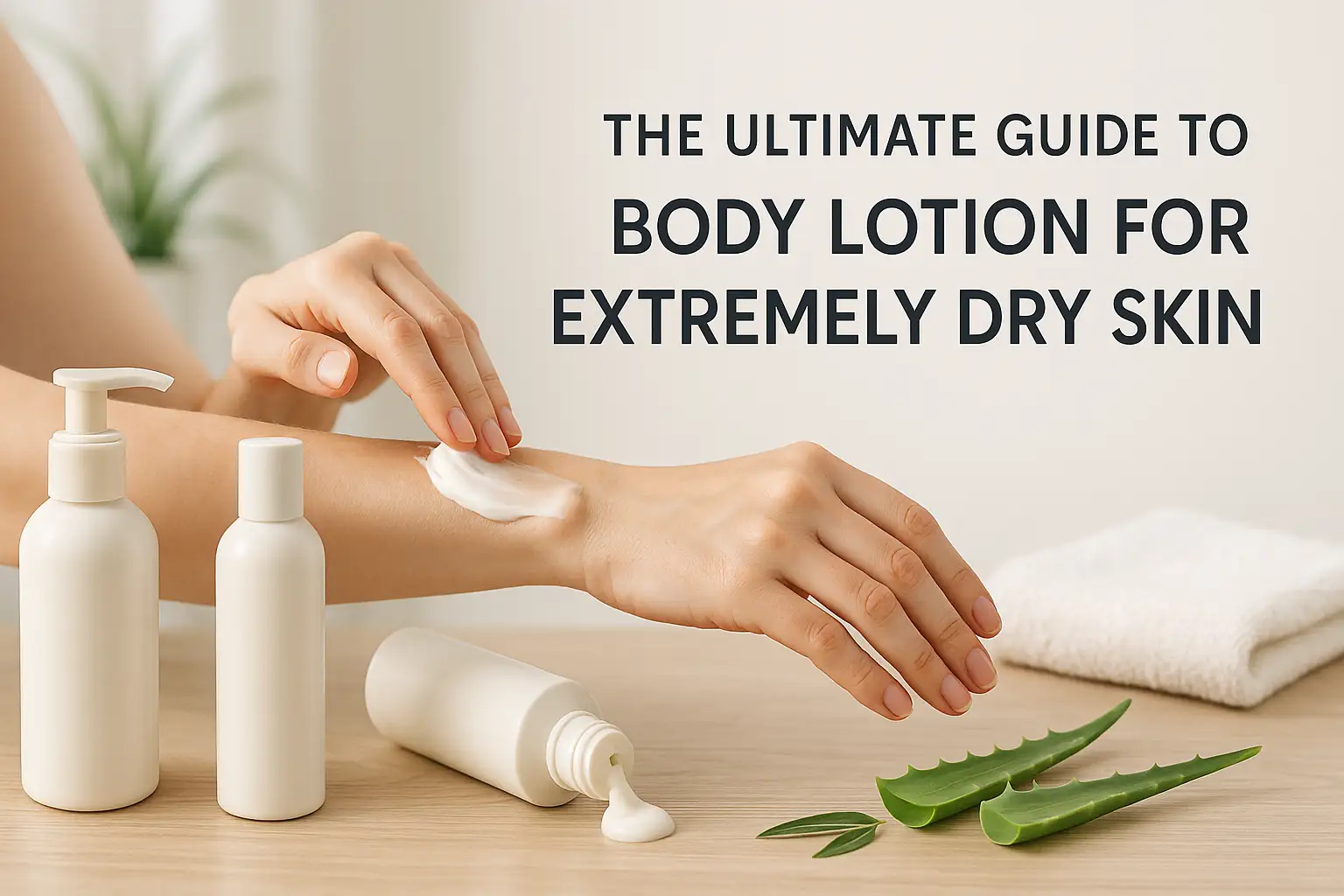If you’re dealing with extremely dry skin, you know it’s more than just a minor inconvenience. It’s tight, itchy, flaky, and sometimes even painful. You’ve probably tried a dozen different bottles promising relief, only to be left feeling disappointed and still searching for that one product that actually works.
Your search ends here. This isn’t just another listicle; this is your Ultimate Guide to Body Lotion for Extremely Dry Skin. We’re diving deep into the science of moisture, the key ingredients to look for, and a curated list of products that truly deliver on their promises. Let’s heal your skin for good.
Understanding Extremely Dry Skin: It’s All About the Barrier
If you have extremely dry skin, you’re not just lacking moisture—you’re likely dealing with a compromised skin barrier. Understanding this is the first and most crucial step to finding a real solution. So, let’s break down what your skin barrier is and why it’s so important.
What Exactly is the Skin Barrier?
Think of your skin’s outermost layer, the stratum corneum, as a sophisticated brick wall.
- The Bricks: These are your skin cells (corneocytes).
- The Mortar: This is a blend of lipids (fats) that hold the cells together. This “mortar” is primarily made up of ceramides, cholesterol, and fatty acids.
This “brick and mortar” structure is your skin’s master defense system. It has two vital jobs:
- Keep the Good Stuff IN: It acts as a seal, preventing Transepidermal Water Loss (TEWL)—the scientific term for moisture evaporating from your skin into the air. When this barrier is healthy, it keeps your skin plump, hydrated, and resilient.
- Keep the Bad Stuff OUT: It shields you from external aggressors like pollution, allergens, harsh weather, and bacteria.
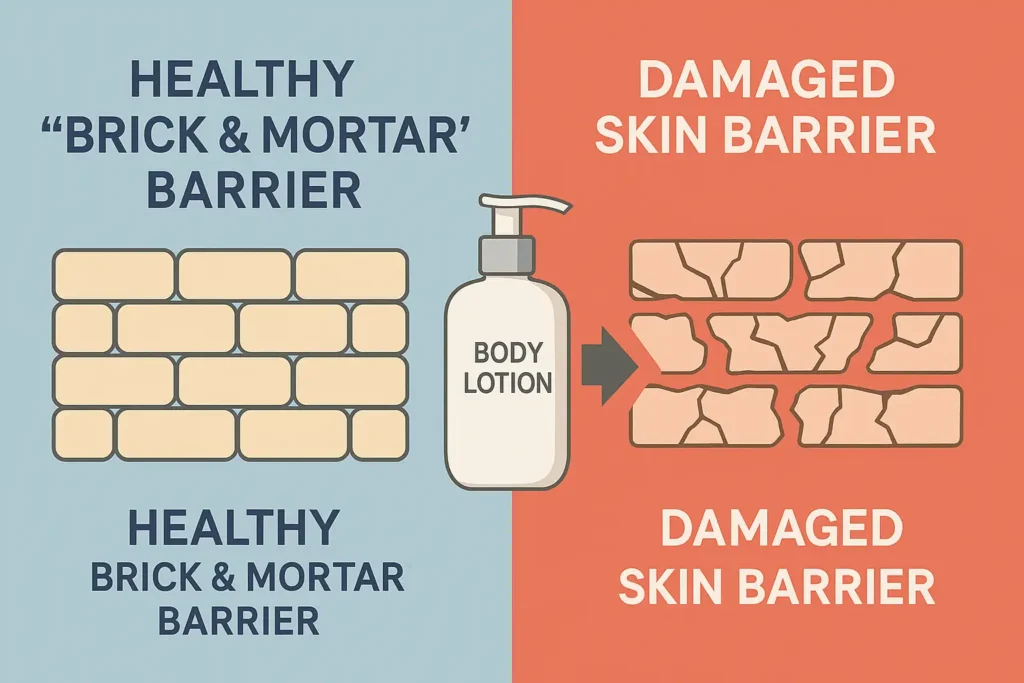
What Happens When the Barrier is Damaged?
When this protective wall is damaged—the “mortar” becomes weak and develops gaps. This is often referred to as a “compromised” skin barrier. Here’s what occurs:
- Moisture Escape: Water escapes through the cracks at an accelerated rate, leaving your skin dehydrated from the inside out. This is why your skin can feel tight and rough.
- Invaders Get In: Irritants, allergens, and pollutants can now penetrate the skin more easily. This leads to inflammation, which manifests as redness, sensitivity, itching, and a stinging sensation when you apply products.
- The Flake Cycle: With accelerated skin cell loss due to dehydration and irritation, you see the visible flakiness and scaling characteristic of extremely dry skin.
Common Causes of Barrier Damage:
- Over-washing or using harsh soaps that strip away natural lipids.
- Low humidity environments (especially in winter or desert climates).
- Hot showers that break down the lipid layer.
- Physical exfoliation with rough scrubs.
- UV radiation from the sun.
- Certain ingredients like drying alcohols and harsh surfactants.
How the Right Body Lotion Fights Back:
A body lotion formulated for extremely dry skin doesn’t just sit on the surface. It works like a construction crew to repair the “brick wall.”
- It Replenishes the “Mortar”: It delivers key lipids, especially ceramides, directly to the skin to rebuild the structural integrity of your barrier.
- It Acts as a Temporary Seal: Using occlusive ingredients, it forms a protective film on top of the skin, immediately reducing water loss while the barrier heals underneath.
- It Attracts and Binds Moisture: Humectants in the formula draw water back into the skin’s surface, rehydrating the parched “bricks.”
By choosing a lotion that targets barrier repair, you’re not just applying a temporary fix; you’re actively healing your skin from the inside out to achieve lasting relief.
What to Look For: The Holy Trinity of Hydration
When you’re dealing with extremely dry skin, slapping on any random lotion just won’t cut it. You need a targeted formula that works in multiple ways to rescue your skin from a state of emergency. The most effective products don’t rely on a single miracle ingredient; they use a strategic combination known as the “Holy Trinity of Hydration.” Think of these three ingredient types as a team of specialists working together to quench, smooth, and protect your skin.
1. Humectants: The Moisture Magnets
What they do: Humectants are hydrophilic, meaning they love water. They act like tiny sponges, drawing moisture from the air (humidity) and from the deeper layers of your skin (dermis) up to the surface (epidermis). This process instantly plumps and rehydrates the outermost layer of your skin, relieving that tight, parched feeling.
Key Players & Why They’re Great:
- Hyaluronic Acid: A superstar humectant capable of holding up to 1,000 times its weight in water. It provides an immediate, noticeable surge of hydration.
- Glycerin: A workhorse humectant found in many effective (and affordable) formulas. It’s incredibly reliable at stabilizing hydration levels in the skin.
- Honey: A natural humectant that also offers antibacterial and soothing properties, making it excellent for irritated, dry skin.
Pro Tip: Humectants work best when there’s moisture available. Applying them to damp skin right after a shower is the perfect way to maximize their effect.
2. Emollients: The “Fillers” and Smoothing Agents
What they do: If your skin is flaky and rough, it’s because the lipid spaces between your skin cells are dry and cracked. Emollients are the fixers. They are oils and lipids that literally “fill in” these gaps by coating the skin cells and creating a smooth, flexible surface. This is what gives skin that soft, “touched” feeling and improves its texture.
Key Players & Why They’re Great:
- Ceramides: These are the gold standard. Ceramides are lipids naturally found in your skin’s barrier. Replenishing them with a lotion is like providing the exact building blocks your skin needs to repair itself.
- Shea Butter: An incredibly rich, nourishing emollient packed with fatty acids and vitamins that melts into the skin, providing deep nourishment and improving elasticity.
- Jojoba Oil: A liquid wax ester that closely mimics our skin’s natural sebum. It’s easily absorbed and non-comedogenic, making it a fantastic, non-greasy emollient.
- Squalane: A lightweight, bio-compatible oil that restores suppleness without clogging pores. It’s derived from olives or sugarcane and is excellent for all skin types.
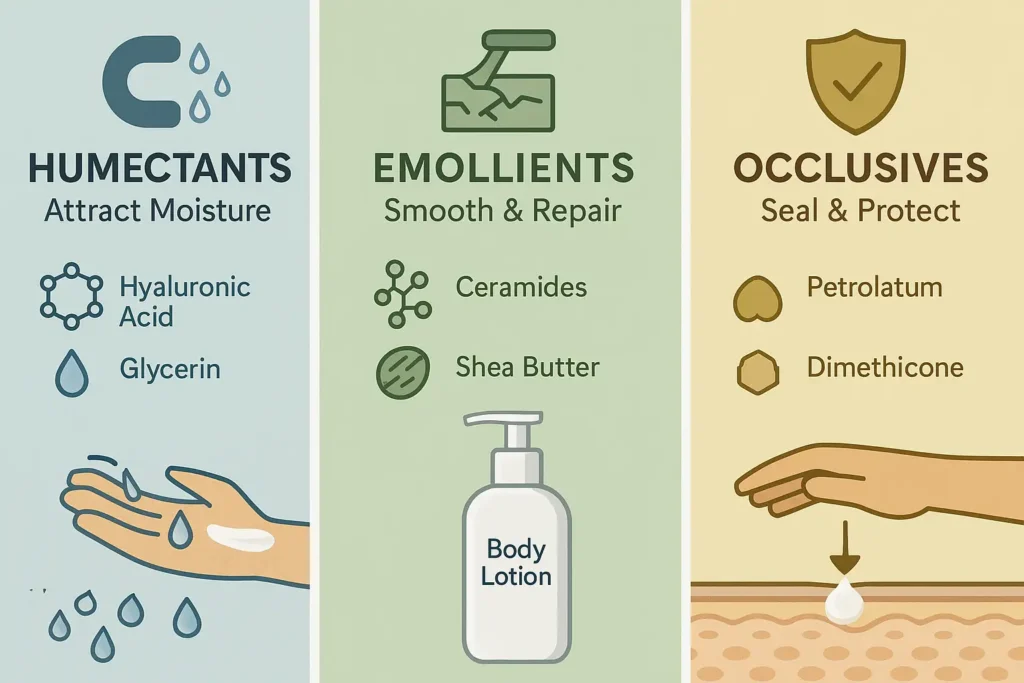
3. Occlusives: The Protective Sealants
What they do: This is the final, crucial step. Occlusives are the bodyguards of your skincare routine. They are typically oily or waxy ingredients that form a protective, water-repellent shield on the very top layer of your skin. This physical barrier dramatically reduces Transepidermal Water Loss (TEWL), locking all the moisture provided by the humectants and emollients into your skin where it belongs.
Key Players & Why They’re Great:
- Petrolatum (Petroleum Jelly): One of the most effective occlusives available, reducing water loss by over 98%. It’s unparalleled for healing severely dry, cracked skin.
- Lanolin: A natural wax secreted by sheep, similar to human sebum. It’s an excellent, protective occlusive, though those with wool allergies should patch test.
- Dimethicone: A silicone-based polymer that provides a silky, protective film. It’s non-greasy, non-comedogenic, and helps to smooth the skin instantly.
- Mineral Oil: A lightweight, odorless, and very effective occlusive that helps prevent moisture loss.
The Perfect Symphony: For extremely dry skin, you need all three. A humectant pulls in water, an emollient smooths and repairs the cracks, and an occlusive slams the door shut to keep the moisture from escaping. A product that contains this “Holy Trinity” is your ticket to lasting hydration.
Ingredients to Actively Avoid
Navigating body lotion labels can feel like reading a foreign language. While hunting for the “Holy Trinity” of hero ingredients, it’s equally crucial to spot the villains that can sabotage your skin’s recovery. For extremely dry and sensitive skin, which is already operating with a compromised barrier, certain ingredients can cause further damage, leading to a cycle of irritation and dehydration. Here’s a detailed breakdown of what to steer clear of and why.
1. Harsh Sulfates: The Overzealous Cleaners
What they are: Sulfates, most notably Sodium Lauryl Sulfate (SLS) and its slightly milder cousin Sodium Laureth Sulfate (SLES), are surfactants. They are what create the rich lather in soaps, shampoos, and even some body washes.
Why they are problematic for dry skin:
Think of your skin’s natural oils (sebum) as part of its essential protective moisture barrier. Harsh sulfates are too effective at their job. They act like powerful detergents, stripping away every trace of oil and dirt. This leaves your skin with that “squeaky clean” feeling, which is actually a sign that your natural protective lipids have been removed.
The Result: This aggressive cleansing disrupts the skin’s lipid barrier, leading to increased Transepidermal Water Loss (TEWL). The aftermath is skin that feels tight, rough, dehydrated, and more vulnerable to irritants. For those with extremely dry skin, this can trigger immediate flakiness and itching.
What to look for on the label: Sodium Lauryl Sulfate, Sodium Laureth Sulfate, Ammonium Lauryl Sulfate.
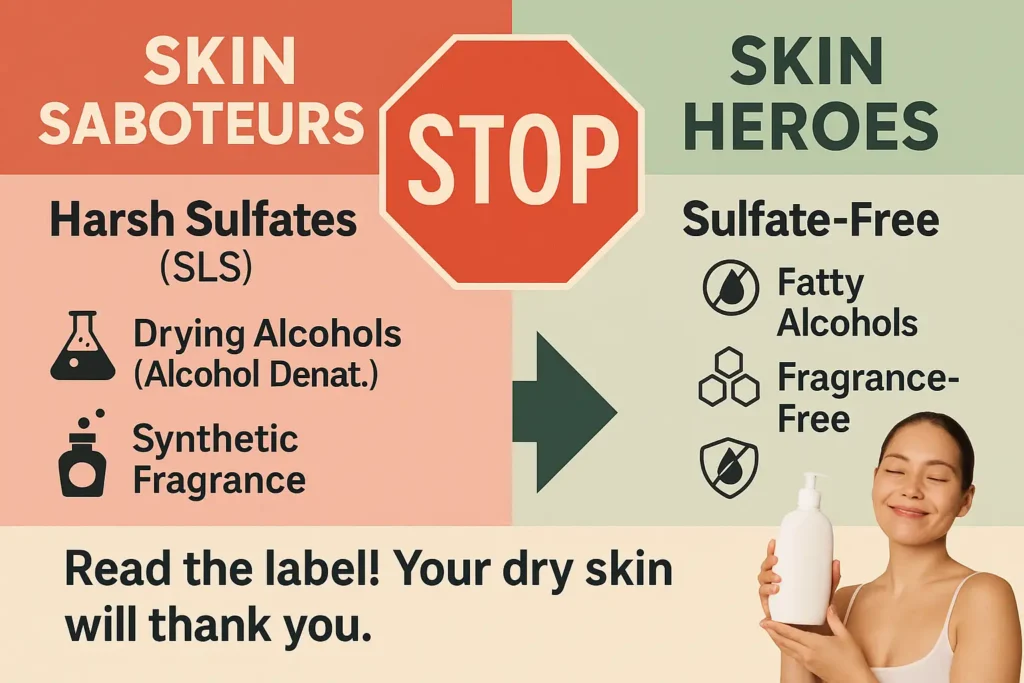
2. Drying Alcohols: The Deceptive Evaporators
What they are: It’s important to note that not all alcohols are bad. Fatty alcohols like Cetyl Alcohol and Stearyl Alcohol are actually excellent, non-irritating emollients that help thicken creams and make them feel luxurious.
The ones you need to avoid are the volatile, short-chain drying alcohols. Common culprits include SD Alcohol, Denatured Alcohol (Alcohol Denat.), and Isopropyl Alcohol.
Why they are problematic for dry skin:
These alcohols are included in formulas for one primary reason: they evaporate quickly. This provides an immediate “cooling” sensation and a fast-drying finish, which can be appealing in certain products. However, this rapid evaporation is a double-edged sword.
As the alcohol evaporates from your skin’s surface, it takes precious moisture with it. Furthermore, these alcohols can dissolve the skin’s natural lipids, directly breaking down the very barrier you’re trying to repair.
The Result: An immediate sensation of dryness and a compromised skin barrier that struggles to hold onto moisture. This can lead to increased sensitivity, redness, and a stinging sensation when you apply other products.
What to look for on the label: Alcohol Denat., Denatured Alcohol, SD Alcohol, Isopropyl Alcohol.
Pro Tip: If an alcohol is listed as one of the first five ingredients, it’s a major red flag for dry skin.
A Note on Fragrance: The Unseen Irritant
While not always a problem for everyone, synthetic Fragrance or Parfum is a common culprit for skin irritation, especially on compromised, dry skin. “Fragrance” is a protected trade secret term that can hide dozens of individual chemical compounds, some of which can be allergenic or irritating. For skin that is already inflamed and sensitive, introducing these potential irritants can trigger redness, itching, and dermatitis, hindering the healing process. Opting for “Fragrance-Free” products is the safest bet for extremely dry and reactive skin.
Our Top-Rated Picks: The Best Body Lotion for Extremely Dry Skin
After analyzing dermatologist recommendations, thousands of user reviews, and ingredient lists, these are our top picks for the best body lotion for extremely dry skin.
1. Best Overall: CeraVe Moisturizing Cream
- Why We Love It: This drugstore hero is a dermatologist favorite for a reason. It’s packed with three essential ceramides to restore your skin’s barrier and hyaluronic acid to lock in moisture. It’s fragrance-free, non-comedogenic, and the rich, non-greasy formula absorbs beautifully.
- Key Ingredients: Ceramides (1, 3, 6-II), Hyaluronic Acid.
- Best For: Anyone looking for a no-fuss, incredibly effective, and affordable solution.
2. Best for Severely Dry & Flaky Skin: Eucerin Advanced Repair Cream
- Why We Love It: When your skin is beyond dry, you need heavy artillery. Eucerin’s formula features a high concentration of ceramides and a unique combination of moisturizers that provide immediate relief and exfoliate dry, flaky patches over time.
- Key Ingredients: Ceramides, Natural Moisturizing Factors (NMF), Glycerin.
- Best For: Tackling rough, bumpy skin on elbows, knees, and heels.
3. Best Luxurious Feel: Kiehl’s Creme de Corps
- Why We Love It: This cult-classic is worth the splurge. It transforms dry, thirsty skin into impossibly soft, smooth skin with a rich but fast-absorbing texture. It’s infused with squalane and cocoa butter for deep, long-lasting nourishment without a greasy residue.
- Key Ingredients: Squalane, Cocoa Butter, Jojoba Oil.
- Best For: A daily moisturizing ritual that feels like a treat.
4. Best Drugstore Value: La Roche-Posay Lipikar AP+M Triple Repair Moisturizing Cream
- Why We Love It: Designed for extra-dry, eczema-prone skin, this cream is a powerhouse. It uses shea butter for intense moisture and prebiotic thermal water to soothe irritation and strengthen the skin barrier. It’s incredibly rich yet gentle enough for the whole family.
- Key Ingredients: Shea Butter, Niacinamide, La Roche-Posay Prebiotic Thermal Water.
- Best For: Sensitive, irritated skin that needs calming and hydration.
5. Best Natural/Oil-Based: SheaMoisture Raw Shea Butter Hydrating Body Lotion
- Why We Love It: For those who prefer natural ingredients, this lotion delivers intense moisture with its signature Raw Shea Butter. Blended with myrrh and frankincense, it provides deep, long-lasting hydration and has a warm, comforting scent.
- Key Ingredients: Raw Shea Butter, Myrrh Extract, Frankincense Extract.
- Best For: Natural skincare enthusiasts and anyone who loves a richly scented experience.
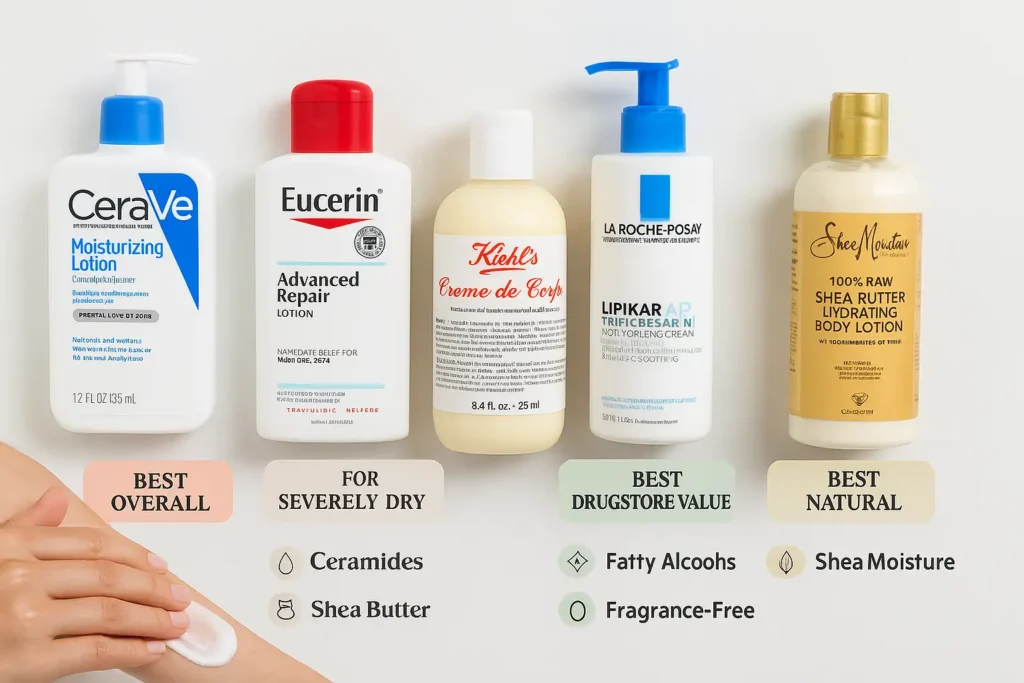
How to Apply Body Lotion for Maximum Effectiveness
You’ve invested in a fantastic body lotion for your extremely dry skin—now, let’s make sure you’re getting every last drop of benefit from it. Applying lotion correctly isn’t just a final step; it’s a technique that can mean the difference between temporary relief and truly transformed skin. Follow these steps to lock in hydration like a pro.
The Golden Routine: A Step-by-Step Guide
Step 1: Shower Smart
The foundation of great hydration is laid before you even reach for the lotion.
- Water Temperature: Resist the urge to take a hot shower. Lukewarm water is your skin’s best friend. Hot water, while feeling soothing in the moment, strips your skin of its natural, protective oils, exacerbating dryness.
- Cleanser Choice: Ditch the harsh, stripping body washes. Opt for a gentle, hydrating cleanser or a syndet (synthetic detergent) bar that is free of sulfates (SLS). Look for labels that say “moisturizing,” “hydrating,” or “for sensitive skin.”
Step 2: Pat Dry, Don’t Rub
When you step out of the shower, be kind to your skin.
- The Method: Use a soft, clean towel to gently pat your skin until it’s no longer dripping, but is still visibly damp to the touch. You should be able to run your hand over your arm and feel moisture.
- Why it matters: Vigorously rubbing your skin with a towel creates micro-abrasions and further irritates a compromised barrier. Patting preserves the skin’s integrity.
Step 3: Apply Immediately (The 3-Minute Rule)
This is the most critical step in the entire process.
- The Science: Your skin is like a sponge when it’s damp. Applying lotion to damp skin allows the humectant ingredients (like Hyaluronic Acid and Glycerin) to pull that surface water into your skin, rather than just working to moisturize the dry, top layer.
- The “Rule”: Try to apply your body lotion within 3 minutes of patting dry. This is the window of opportunity when your skin is most receptive to absorbing and sealing in all that hydration.
Step 4: Use Generous Amounts
Skimping on product is a false economy when dealing with extremely dry skin.
- Be Liberal: Don’t just use a tiny dot for your whole arm. Use a generous, palm-sized amount for your entire body. Extremely dry skin needs a thick, protective layer of emollients and occlusives to repair itself. If your skin still feels tight or dry after the lotion has absorbed, you’re likely not using enough.
Step 5: Massage Gently & Thoroughly
How you apply it matters for absorption and circulation.
- The Technique: Pour the lotion into your palms to warm it up slightly. Then, using the palms of your hands and your fingertips, massage the lotion into your skin using upward, circular motions.
- Why it works: This gentle massage helps stimulate blood flow, which can promote healing. The circular motions ensure the product is worked into the skin thoroughly, rather than just sitting on the surface. Continue massaging until the lotion is fully absorbed.
Pro-Tip for Trouble Spots: Pay extra attention to areas that are typically drier, like your shins, elbows, knees, and feet. For these areas, you might even consider a second, thinner layer of lotion once the first has absorbed.
Lifestyle Tips to Complement Your Routine
- Hydrate from Within: Drink plenty of water throughout the day.
- Use a Humidifier: Adding moisture to the air, especially in dry climates or during winter, can prevent your skin from losing hydration.
- Exfoliate Gently: Use a gentle chemical exfoliant (like a lotion with Lactic Acid) once a week to slough off dead skin cells, allowing your moisturizer to penetrate better. Avoid harsh physical scrubs.
Frequently Asked Questions (FAQ)
Q: What’s the difference between a lotion, a cream, and an ointment?
A: It comes down to oil and water content. Lotions are light and watery. Creams are richer and thicker, making them ideal for extremely dry skin. Ointments are the heaviest, oil-based products (like Vaseline) and are best for spot-treating the driest areas.
Q: How often should I apply body lotion for extremely dry skin?
A: At least twice a day – once in the morning and once after your shower. You may need to reapply more frequently on extra-dry areas like hands, elbows, and shins.
Q: Can body lotion help with eczema?
A: Yes, but look for products specifically labeled for eczema-prone skin. These are typically free of fragrances and dyes and contain barrier-repairing ingredients like ceramides and colloidal oatmeal.
The Final Word
Finding the best body lotion for extremely dry skin is a personal journey, but it doesn’t have to be a difficult one. The key is to look for products rich in barrier-repairing ceramides, moisture-binding humectants, and protective occlusives. Whether you choose the dermatologist-loved CeraVe Moisturizing Cream or the luxurious Kiehl’s Creme de Corps, consistent use is the true secret to transforming your skin from dry and distressed to soft, smooth, and deeply hydrated.
Say goodbye to the itch and discomfort—your skin deserves this ultimate level of care.
Ressources
Dermatological Associations & Educational Resources
- American Academy of Dermatology Association (AAD) – Dry Skin:
A comprehensive overview of causes, symptoms, and treatments for dry skin directly from board-certified dermatologists.
https://www.aad.org/public/everyday-care/skin-care-basics/dry/dry-skin - **National Eczema Association:
** An invaluable resource for those whose extremely dry skin may be related to eczema, including product directories and ingredient guides.
https://nationaleczema.org/ - The Skin Cancer Foundation – Skin Care & Moisturizers:
Discusses the importance of skin care and moisturization for overall skin health.
https://www.skincancer.org/skin-care/moisturizers/
Ingredient Databases & Scientific Insight
- INCIDEcoder®:
A fantastic tool for consumers to decode complex ingredient lists. You can search for any ingredient mentioned in this post to get a detailed, easy-to-understand explanation of its function.
https://incidecoder.com/ - Paula’s Choice INGREDIENT DICTIONARY:
A well-researched database that provides in-depth information on the benefits and potential drawbacks of skincare ingredients.
https://www.paulaschoice.com/ingredient-dictionary - PubMed.gov:
A database from the National Institutes of Health (NIH) where you can find scientific studies on skincare ingredients. (e.g., search “ceramides skin barrier repair”).
https://pubmed.ncbi.nlm.nih.gov/
Brand Websites & Product Information
- CeraVe:
Learn more about their formulation philosophy with ceramides and MVE® technology.
https://cerave.com/ - Eucerin:
Explore the science behind their Advanced Repair line and other products for extremely dry skin.
https://www.eucerin.com/ - Kiehl’s Since 1851:
Discover the story and ingredients behind Creme de Corps.
https://www.kiehl.com/ - La Roche-Posay:
Learn about their commitment to dermatological skincare and the Lipikar line.
https://www.laroche-posay.us/ - SheaMoisture:
Explore their range of naturally inspired products and ethical sourcing stories.
https://www.sheamoisture.com/

